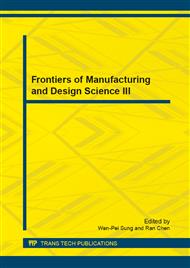p.412
p.417
p.422
p.427
p.432
p.437
p.442
p.447
p.452
Error Analysis of the Modeling and Assembly of Gears with Asymmetric Tooth Profile
Abstract:
Gears have been extensively employed in transmission machinery. Among the various and variant types of gears, helical gears have the characteristics of low vibration and low noise, and are especially apt for application in industrial machines. This study proposes to use mathematic geometric equations to compose the programming language via which point data are obtained and processed by Solid Works to complete the construction of the model. As for assembly error and stress analysis, the constructed model is then converted into ANSYS Workbench for implementing the stress analysis of the transmission under the condition of ideal assembly and of erroneous assembly. This study focuses on the impact of assembly error on the transmission in regard to the different pressure angles of the driver side of a helical gear with asymmetric teeth. The results show that the bigger the pressure angle of the driver side of the helical gear, the less stress during the transmission. Furthermore, the stress would increase when a minimum axial error is set. In conclusion, assembly error will cause uneven stress distribution, resulting in reduced service life and other problems.
Info:
Periodical:
Pages:
432-436
Citation:
Online since:
December 2012
Authors:
Keywords:
Price:
Сopyright:
© 2013 Trans Tech Publications Ltd. All Rights Reserved
Share:
Citation:


